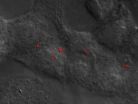(Press-News.org) By following the "nose" of fruit flies, Yale scientists are on the trail of new insect repellents that may reduce the spread of infectious disease and damage to agricultural crops. That's because they've learned for the first time how a group of genes used to differentiate smells is turned on and off, opening new possibilities for insect control. Just as in new drug development, researchers can target these or similar genes in other insects to create substances that make crops and people "invisible" to insect antennae. Without the ability to smell correctly, the insects are far less likely to attack a person or plant, as is the case with mosquitoes whose ability to smell lactic acid is disrupted by the active ingredient in insect repellents, DEET. This finding is reported in the September 2010 issue of the journal GENETICS (http://www.genetics.org).
According to Carson Miller, a researcher involved in the work from the Department of Molecular, Cellular and Developmental Biology at Yale University, "One of the fundamental questions in biology is, 'how does a cell choose which genes it should turn on and which genes it should turn off?' By studying this question in odor-sensitive neurons of fruit flies, we hope to learn how cells make these choices, as well as to develop more effective odor-based insect repellents."
The scientists studied four genes from a group of odor receptor genes in the fruit fly. These genes afford flies the ability to detect different scents. Pieces of DNA in front of these genes contained enough information to tell the fly to turn on these genes in specific cells of the antenna. Miller made an artificial reporter gene that used the regulatory DNA in front of an Odor receptor gene to control a test gene that could be easily monitored for expression. An entire set of such reporter genes were created, each containing less of the regulatory DNA. The goal was to determine how short the regulatory region could be and yet still control the test gene normally. This helped Miller to identify where the important control elements lie in the regulatory DNA, and whether they serve to turn the gene on in cells where it is needed or to turn the gene off where it doesn't belong.
"The sense of smell is an Achilles heel for many insects," said Mark Johnston, Editor-in-Chief of the journal GENETICS, "and the more we learn about odor receptors the easier it will be to interfere with them to battle insect-borne disease and crop devastation. This study is a step forward in doing that by identifying the mechanism that results in the highly selective expression of 'smell genes'."
INFORMATION:
DETAILS: Carson J. Miller and John R. Carlson. Regulation of odor receptor genes in trichoid sensilla of the Drosophila antenna. Genetics 2010 186:79-95.
Since 1916, the journal GENETICS (http://www.genetics.org) has covered high quality, original research on a range of topics bearing on inheritance, including population and evolutionary genetics, complex traits, developmental and behavioral genetics, cellular genetics, gene expression, genome integrity and transmission, and genome and systems biology. GENETICS, the peer-reviewed, peer-edited journal of the Genetics Society of America is one of the world's most cited journals in genetics and heredity.
Fruit flies help Yale scientists sniff out new insect repellents
Research published in the journal Genetics identifies pieces of control DNA that turn on or off genes that allow fruit flies to differentiate between smells, paving the way for better insect repellents
2010-09-22
ELSE PRESS RELEASES FROM THIS DATE:
GOES-13's wide view of Atlantic's Tropical Storm Lisa and low, Pacific's Georgette
2010-09-22
The GOES-13 satellite may be stationed in orbit over the eastern U.S., but it has a wide field of view from the eastern Atlantic to the eastern Pacific, and today it captured three tropical cyclones in one image.
At 1445 UTC (10:45 a.m. EDT) today, Sept. 22, the Geostationary Operational Environmental Satellite called GOES-13 captured Tropical Storm Lisa in the far eastern Atlantic, a developing tropical low in the south-central Caribbean Sea, and Tropical Storm Georgette in the eastern Pacific Ocean, making landfall in Baja California. The GOES series of satellites ...
Huge post-tropical Hurricane Igor drenched Newfoundland, Canada
2010-09-22
Hurricane Igor may have transitioned into a post-tropical hurricane late yesterday, but when he approached Newfoundland, Canada and merged with an area of low pressure it resulted in heavy rainfall throughout the region. NASA satellites captured Igor's northern march toward the Labrador Sea yesterday.
NASA's Terra and Aqua satellites captured visible and infrared images of Hurricane Igor yesterday as he brought heavy rainfall into northeastern Canada. A visible image of Hurricane Igor over Newfoundland, Canada was captured by the Moderate Resolution Imaging Spectroradiometer ...
Human-powered ornithopter becomes first ever to achieve sustained flight
2010-09-22
TORONTO, ON – Aviation history was made when the University of Toronto's human-powered aircraft with flapping wings became the first of its kind to fly continuously.
The "Snowbird" performed its record-breaking flight on August 2 at the Great Lakes Gliding Club in Tottenham, Ont., witnessed by the vice-president (Canada) of the Fédération Aéronautique Internationale (FAI), the world-governing body for air sports and aeronautical world records. The official record claim was filed this month, and the FAI is expected to confirm the ornithopter's world record at its meeting ...
Humanized mice may provide clues to better prevent and treat typhoid fever
2010-09-22
Better treatments and prevention for typhoid fever may emerge from a laboratory model that has just been developed for the disease. The model is based on transplanting human immune stem cells from umbilical cord blood into mice that are susceptible to infections.
The transplanted cells live alongside the mouse's own immune system. Although mice are normally resistant to the dangerous strain of Salmonella that causes typhoid fever, the bacteria are able to reproduce in the mice that have received transplanted human cells.
Because typhoid fever affects only humans, ...
Positive behavioral interventions programs found to improve student behavior and learning
2010-09-22
Los Angeles, CA (September 22, 2010) Adopting the evidence-based procedures of School-Wide Positive Behavioral Interventions and Supports (SWPBIS) helped 21 elementary schools reduce student suspensions, office discipline referrals and improve student academic achievement, according to a study published in the July 2010 issue of the Journal of Positive Behavior Interventions. SWPBIS is a rapidly expanding approach to improving educational environments that is estimated to be used in more than 9,000 schools nation-wide
Researchers at the Johns Hopkins Center for the Prevention ...
Experience, privacy guide how people choose online news
2010-09-22
Adjustments, applications and other tools allow users to configure preferences and use services such as iGoogle and Yahoo to control and customize the news they consume online. These tools can make online experiences more efficient and productive, but they do not ensure that users will be consistently pleased with their selections, according to Penn State researchers.
"There is a major push toward customization in the marketplace because designers assume that more customization is better, but our research shows that only some users prefer customization," said S. Shyam ...
Losing your religion deemed unhealthy
2010-09-22
People who leave strict religious groups are more likely to say their health is worse than members who remain in the group, according to a Penn State researcher.
The percentage of people who left a strict religious group and reported they were in excellent health was about half that of people who stayed in the group, said Christopher Scheitle, senior research assistant, in sociology.
"Previous research showed some association between belonging to a religious group and positive health outcomes," Scheitle said. "We became interested in what would happen to your health ...
Gum disease found to be significant public health concern
2010-09-22
September 21, 2010 – Chicago – The prevalence of periodontal disease in the United States may be significantly higher than originally estimated. Research published in the Journal of Dental Research from the Centers for Disease Control and Prevention (CDC) and the American Academy of Periodontology (AAP) suggests that the prevalence of periodontal disease may have been underestimated by as much as 50 percent. The implication is that more American adults may suffer from moderate to severe gum disease than previously thought.
In a National Health and Nutrition Examination ...
Study: Doctors overprescribe antibiotics for respiratory infections
2010-09-22
Doctors frequently misuse antibiotics when treating patients hospitalized with respiratory tract infections (RTIs), according to a study to be published in the November issue of Infection Control and Hospital Epidemiology.
The study, which tracked patients in two Pennsylvania hospitals, found that doctors often use antibiotics to treat patients whose infections are known to be caused by viruses. The findings are alarming because antibiotics are not effective against viruses, and antibiotic overuse has been linked to the development of resistant bacterial strains.
"[T]hese ...
Introducing 'Champagne,' new disease-resistant fig
2010-09-22
BATON ROUGE, LA—The ancient fig tree, first imported to the United States during the 16th century, thrives in areas of California and the South Atlantic and Gulf Coast areas of the U.S. One of the most popular trees grown in Southern backyards, fig is favored for its versatile fruit and low-maintenance production.
Charles E. Johnson, Ed O'Rourke, and James E. Boudreaux, from the Louisiana State University Agricultural Center in Baton Rouge, introduced a new fig they named "Champagne" in a recent issue of HortScience. According to the report, the new fig performed well ...
LAST 30 PRESS RELEASES:
Austrian cow shows first case of flexible, multi-purpose tool use in cattle
Human nasal passages defend against the common cold and help determine how sick we get
Research alert: Spreading drug costs over the year may ease financial burden for Medicare cancer patients
Hospital partnership improves follow up scans, decreases long term risk after aortic repair
Layered hydrogen silicane for safe, lightweight, and energy-efficient hydrogen carrier
Observing positronium beam as a quantum matter wave for the first time
IEEE study investigates the effects of pointing error on quantum key distribution systems
Analyzing submerged fault structures to predict future earthquakes in Türkiye
Quantum ‘alchemy’ made feasible with excitons
‘Revoice’ device gives stroke patients their voice back
USF-led study: AI helps reveal global surge in floating algae
New method predicts asthma attacks up to five years in advance
Researchers publish first ever structural engineering manual for bamboo
National poll: Less than half of parents say swearing is never OK for kids
Decades of suffering: Long-term mental health outcomes of Kurdish chemical gas attacks
Interactional dynamics of self-assessment and advice in peer reflection on microteaching
When aging affects the young: Revealing the weight of caregiving on teenagers
Can Canada’s health systems handle increased demand during FIFA World Cup?
Autistic and non-autistic faces may “speak a different language” when expressing emotion
No clear evidence that cannabis-based medicines relieve chronic nerve pain
Pioneering second-order nonlinear vibrational nanoscopy for interfacial molecular systems beyond the diffraction limit
Bottleneck in hydrogen distribution jeopardises billions in clean energy
Lung cancer death rates among women in Europe are finally levelling off
Scientists trace microplastics in fertilizer from fields to the beach
The Lancet Obstetrics, Gynecology, & Women’s Health: Taking paracetamol during pregnancy does not increase risk of autism, ADHD or intellectual disabilities, confirms new gold-standard evidence review
Taking paracetamol during pregnancy does not increase risk of autism, ADHD or intellectual disabilities
Harm reduction vending machines in New York State expand access to overdose treatment and drug test strips, UB studies confirm
University of Phoenix releases white paper on Credit for Prior Learning as a catalyst for internal mobility and retention
Canada losing track of salmon health as climate and industrial threats mount
Molecular sieve-confined Pt-FeOx catalysts achieve highly efficient reversible hydrogen cycle of methylcyclohexane-toluene
[Press-News.org] Fruit flies help Yale scientists sniff out new insect repellentsResearch published in the journal Genetics identifies pieces of control DNA that turn on or off genes that allow fruit flies to differentiate between smells, paving the way for better insect repellents


